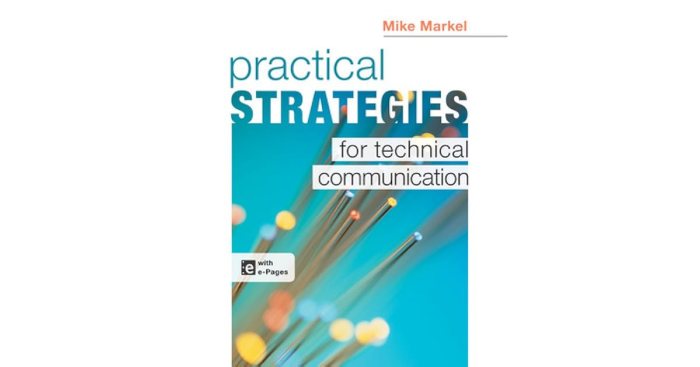Practical strategies for technical communication 4th edition – Practical Strategies for Technical Communication, 4th Edition, delves into the complexities of technical writing, providing readers with a comprehensive guide to creating clear, concise, and effective technical documents. This extensively revised edition offers a wealth of practical strategies, insights, and best practices for navigating the challenges of technical communication in today’s rapidly evolving technological landscape.
With a focus on clarity, conciseness, and organization, this book provides a systematic approach to writing various types of technical documents, including reports, proposals, specifications, and user manuals. It emphasizes the importance of audience analysis, tailoring content to specific readers, and incorporating visual aids to enhance comprehension.
Overview of Practical Strategies for Technical Communication, 4th Edition
The fourth edition of Practical Strategies for Technical Communication provides a comprehensive guide to the principles and practices of effective technical writing. It is designed for students, professionals, and anyone who needs to communicate technical information clearly and effectively.
This updated edition includes significant revisions and new content, including:
- Expanded coverage of visual communication and document design
- In-depth discussion of emerging trends in technical communication, such as artificial intelligence and machine learning
- Updated examples and case studies throughout
Principles of Effective Technical Communication
Effective technical communication is clear, concise, and organized. It is tailored to the needs of the audience and uses visuals to enhance comprehension. Technical communicators must understand the principles of effective communication in order to produce documents that are both informative and engaging.
Audience Analysis, Practical strategies for technical communication 4th edition
Audience analysis is the process of understanding the needs and expectations of the audience. This information can be used to tailor the content, tone, and style of the document to the specific audience.
Tailoring Content
Tailoring content means adapting the document to the specific needs of the audience. This may involve using different levels of technical detail, providing background information, or using specific examples that are relevant to the audience.
Writing for Different Purposes and Audiences: Practical Strategies For Technical Communication 4th Edition

Technical documents can be classified into different types, each with its own unique purpose and audience. Common types of technical documents include:
- Reports
- Proposals
- Instructions
- Technical manuals
Each type of document requires a different writing strategy and consideration. For example, reports are typically written to provide information, while proposals are written to persuade the reader to take action.
Visual Communication and Document Design
Visual communication is an essential part of technical writing. Visuals can help to clarify complex concepts, make information more memorable, and improve the overall readability of a document.
Common types of visuals used in technical writing include:
- Graphs
- Charts
- Tables
- Images
When designing a document, it is important to consider the following factors:
- Layout
- Font
- Color
- White space
Collaboration and Teamwork in Technical Communication
Collaboration is essential in technical writing projects. Technical communicators often work with subject matter experts, designers, and other stakeholders to produce a finished document.
Effective collaboration requires:
- Clear communication
- Conflict resolution
- Peer review
Detailed FAQs
What are the key updates in the 4th edition of Practical Strategies for Technical Communication?
The 4th edition includes significant updates and revisions, such as new chapters on visual communication and document design, collaboration and teamwork, and emerging trends in technical communication.
How can I use this book to improve my technical writing skills?
Practical Strategies for Technical Communication provides a step-by-step approach to writing effective technical documents, with practical strategies, examples, and exercises to enhance clarity, conciseness, and organization.
What are the ethical considerations I should be aware of as a technical communicator?
The book covers ethical responsibilities in technical communication, including copyright, plagiarism, intellectual property, and ensuring the accuracy and integrity of technical information.